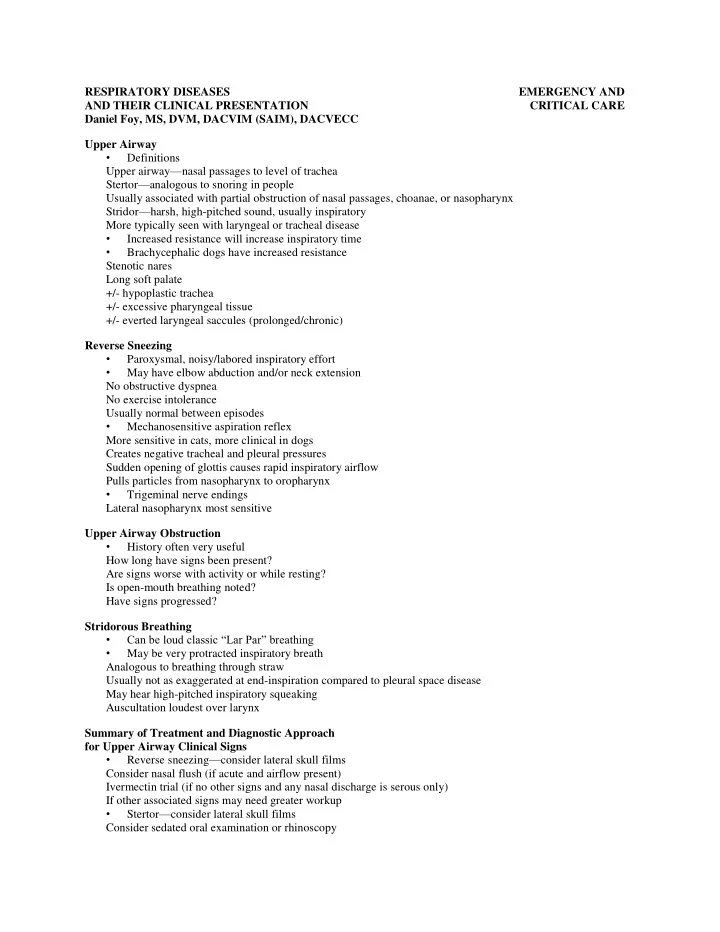

RESPIRATORY DISEASES EMERGENCY AND AND THEIR CLINICAL PRESENTATION CRITICAL CARE Daniel Foy, MS, DVM, DACVIM (SAIM), DACVECC Upper Airway • Definitions Upper airway — nasal passages to level of trachea Stertor — analogous to snoring in people Usually associated with partial obstruction of nasal passages, choanae, or nasopharynx Stridor — harsh, high-pitched sound, usually inspiratory More typically seen with laryngeal or tracheal disease • Increased resistance will increase inspiratory time • Brachycephalic dogs have increased resistance Stenotic nares Long soft palate +/- hypoplastic trachea +/- excessive pharyngeal tissue +/- everted laryngeal saccules (prolonged/chronic) Reverse Sneezing • Paroxysmal, noisy/labored inspiratory effort • May have elbow abduction and/or neck extension No obstructive dyspnea No exercise intolerance Usually normal between episodes • Mechanosensitive aspiration reflex More sensitive in cats, more clinical in dogs Creates negative tracheal and pleural pressures Sudden opening of glottis causes rapid inspiratory airflow Pulls particles from nasopharynx to oropharynx • Trigeminal nerve endings Lateral nasopharynx most sensitive Upper Airway Obstruction • History often very useful How long have signs been present? Are signs worse with activity or while resting? Is open-mouth breathing noted? Have signs progressed? Stridorous Breathing • Can be loud classic “Lar Par” breathing • May be very protracted inspiratory breath Analogous to breathing through straw Usually not as exaggerated at end-inspiration compared to pleural space disease May hear high-pitched inspiratory squeaking Auscultation loudest over larynx Summary of Treatment and Diagnostic Approach for Upper Airway Clinical Signs • Reverse sneezing — consider lateral skull films Consider nasal flush (if acute and airflow present) Ivermectin trial (if no other signs and any nasal discharge is serous only) If other associated signs may need greater workup • Stertor — consider lateral skull films Consider sedated oral examination or rhinoscopy
Surgical correction for BAS (if indicated) • Stridor — chest and lateral cervical films Sedated oral and laryngeal examination Consider tracheoscopy Cough • Sudden expiratory effort Initially against closed glottis Usually has strong inspiration immediately preceding cough • Effort to clear airways and lungs of real/perceived foreign material • Loudness often correlates with size of affected airway • CXR almost always essential initial test Evaluate parenchyma, pleural space, and CV system • Cough correlates with largest airway affected • CXR indicated as many causes of cough — multiple films if evaluating for collapse Heart disease (dogs) Infectious (bacterial, fungal) Inflammatory (bronchitis, asthma) Pleural effusion Tracheal/bronchial collapse Neoplasia Bronchitis and Asthma • Both conditions cause increased expiratory effort Bronchitis — intraluminal mucous, fibrosis and endobronchial narrowing, muscle hypertrophy Asthma — mucous secretion, muscle hypertrophy and constriction, airway edema • May be triggered by environmental allergens, airborne irritants, infectious disease, etc. • Historical and clinical findings Chronic/slowly progressive May acutely exacerbate — can worsen with stress, exercise, cold Dogs often overweight Cough or wheeze Expiratory effort Often sinus arrhythmia or bradycardia • Thoracic radiographs indicated • Additional diagnostics necessary to confirm Tracheal wash, bronchoscopy, and BAL Cytology and culture of pulmonary samples Pulmonary Parenchymal Disease • Clinical findings Harsh lung sounds ± crackles — may be focal • Lungs develop decreased compliance Requires greater pressure to expand lungs Major symptom — greater exertion with expiration Note both increased inspiratory and expiratory effort Inspiratory effort often more notable • Often associated with greater hypoxemia • CXR indicated • Frequently requires additional workup CBC Chemistry Cultures Additional laboratory testing as indicated Pleural Space Disease • Potential space
• Contains 1 – 5 ml fluid (lubricates lungs) • Normal pleural pressure = -3 to -5 cm H 2 O • Occurs when pleural space occupied by abnormal contents • Air • Fluid • Neoplasia • Abdominal organs • Clinical signs • Shallow and rapid breaths • Cough • Fever • Patients need to work significantly harder to expand chest • Must overcome air/fluid occupying pleural space • No longer negative pressure within pleural space • Increased inspiration and often appear to have dramatic relaxation post-inspiration • Thoracic films indicated • If patient severely affected, perform thoracocentesis first to stabilize • Tap dorsal 1/3 if suspect pneumothorax • Tap ventral 1/3 if suspect pleural effusion • Aim for 6th – 8th ICS • Consider repeat films post-tap Trauma (flail chest) • Secondary to ≥ 2 consecutive rib fractures Usually result of blunt trauma/bites • Paradoxic movement of flail segment during respiration • Often associated with significant additional intrathoracic trauma Flail segment itself likely responsible for very minor decrease in P a O 2 (likely pain/hypoventilation) • Thoracic films — evaluate extent of damage • Likely O 2 support Usually significant thoracic trauma • External bandage if wounds present • Consider surgical repair in severe cases (or if thoracotomy indicated for other reasons) Option of percutaneous repair References Byers CG, Dhupa N. Feline bronchial asthma: pathophysiology and diagnosis. Compend Contin Edu Pract Vet 2005;27(6):418 – 425. Byers CG, Dhupa N. Feline bronchial asthma: treatment. Compend Contin Edu Pract Vet 2005;27(6):426 – 432. Fleming E, Ettinger S. Pulmonary hypertension. Compend Contin Edu Pract Vet 2006;28(10):720 – 733. King LG, ed. Textbook of respiratory disease in dogs and cats . St. Louis: Elsevier, 2004. Maritato K, Colon JA, Kergosien D. Pneumothorax. Compend Contin Edu Pract Vet 2009;31(5):232 – 242. McKiernan BC. Diagnosis and treatment of canine chronic bronchitis: twenty years of experience. Vet Clin North Am Small Anim Pract 2000;30(6):1267 – 1278. Mercurio A. Complications of upper airway surgery in companion animals. Vet Clin North Am Small Anim Pract 2011;41(5):969 – 980. New H, Byers CG. Pulmonary thromboembolism. Compend Contin Edu Pract Vet 2011;33(9):E1 – E7. Nykamp SG, Scrivani PV, Dykes NL. Radiographic signs of pulmonary disease: an alternative approach. Compend Contin Edu Pract Vet 2002;24(1):25-36 Smith MM. Diagnosing laryngeal paralysis. J Am Anim Hosp Assoc 2000;36(5):383 – 384.
Recommend
More recommend